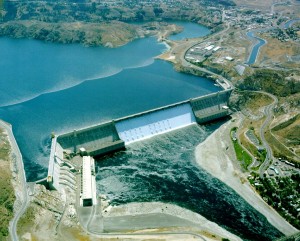This Christmas season is becoming downright Dickensian, haunted by the spirits of Depressions past and present, while the sound-bitten mongrels of political punditry howl dogmatically about the spirit of Depressions yet to come. In the midst of these depressing thoughts, I’ve had to surrender my now obsolete high-powered analog cell phone (it worked fine in Northern California’s wilds) and replace it with an overachieving digital device. It’s not all bad. It might let me use Aaron Copeland’s “Fanfare for the Common Man” as a ring tone. Copeland’s piece is interesting historically, one of eighteen fanfares commissioned in WWII by the Cleveland Symphony orchestra to play before each concert to honor U.S. soldiers, sailors and airmen. Copeland’s is the only memorable one, perhaps the most inspiring piece of American music ever written, absolutely striking in its tone and clarity.
Many of Roosevelt’s ‘New Deal’ speeches are similarly inspirational but his programs were a hodge-podge, which Roosevelt nicely packaged as “bold, continuous experimentation.” Current Washington debates on bailouts, stimulus packages and the effectiveness of the New Deal in ending the Great Depression miss the point. The New Deal gave hope to the 25% of unemployed workers that they would not starve while Roosevelt tried many ways to get people back to work and the economy back on track. At the same time, he had to manage the nasty political fact that for many of the 75% of people lucky enough to keep their jobs, the Depression was not a bad time—everything cost less and money went further. The New Deal’s most important aspect was not structure but philosophy: who should benefit. A muddle for the common man.
Much of Roosevelt’s inspired muddling worked, largely because he put strong, principled people in charge. Two served through his entire administration: Harold Ickes as Secretary of the Interior, and Frances Perkins as Secretary of Labor. A graduate of Mt. Holyoke and Columbia University, Perkins was the first woman to serve in the U.S. Cabinet. Roosevelt supported almost all her goals to improve the lot of the common citizen. Without her, there would be no Social Security as we know it, no minimum-wage laws, no unemployment insurance and none of the host of other pieces of New Deal legislation integral to the social safety net that stabilizes America to this day.
Harold Ickes served as Roosevelt’s Secretary of the Interior and simultaneously as Director of the Public Works Administration. He saw that massive Federal power programs would employ tens of thousands. Revenues from the sale of power could repay carefully structured bonds to attract private capital that had little place else to go during the Depression. The Public Works Administration completed billions of dollars of projects that revitalized American industry and stabilized utilities costs for decades. Locally, he tried unsuccessfully to stop the City of San Francisco’s sale of Hetch Hetchy power to PG&E, claiming it violated the Raker Act, which claims that no private profit could be derived from power produced on Federal lands.
Ickes also championed civil rights, serving as NAACP President in Chicago (surprisingly, many early NAACP leaders were white). The Daughters of the American Revolution (DAR) prevented internationally famed contralto Marian Anderson from singing at the DAR Constitution Hall in Washington because of her race. Ickes, as Secretary of the Interior, arranged for her to perform on the steps of the Lincoln Memorial. Her Easter Sunday concert enthralled 75,000 Americans across the entire racial spectrum along with a radio audience of millions. In many ways the concert was a tipping point in the Civil Rights movement, as the New Deal was for the rights of the working population.
It’s always good to look for something hopeful as the winter nights lengthen. Winter Solstice fell on December 21, and days will soon start growing longer again and we will have a new President and real hope of change and a new year to make of it what we will. Taking a larger view, here we are again, sitting on a pretty blue planet, warmed as we circle a rather typical type G star, located in a remote spiral arm of a nice but unexceptional galaxy, and we’ve made it round one more time. Regardless of your perspective on who, if anyone, really runs the show, it’s hard to fault Tiny Tim’ s last hopeful, redeeming and inclusive line from Dickens’ A Christmas Carol. “God Bless us all. Everyone.”
Season’s Best and a Somewhat Logical New Year.




